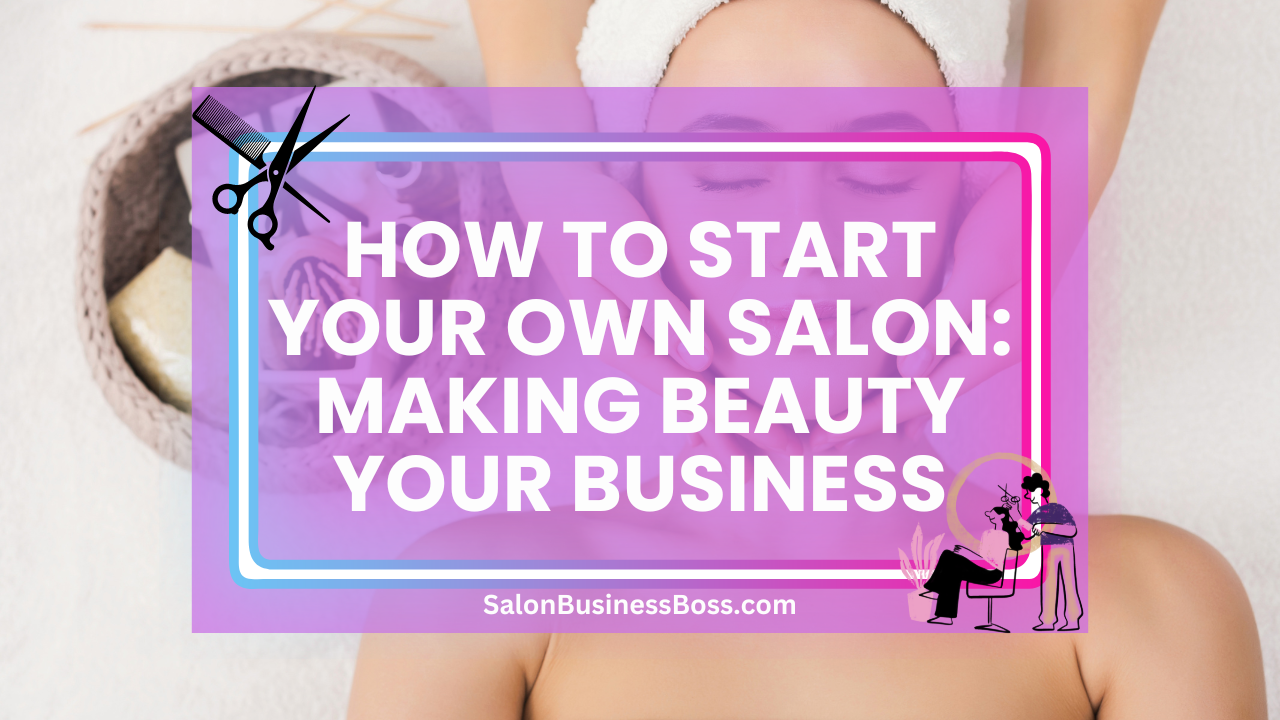Opening your own salon can be an exciting and rewarding venture for those passionate about beauty, aesthetics, and customer service. However, it requires careful planning, attention to detail, and a deep understanding of the beauty industry.
To open your own salon, start with thorough market research and a well-crafted business plan. Choose a prime location, design an inviting interior, and invest in high-quality equipment. Hire skilled staff, offer a variety of services at competitive prices, and focus on exceptional customer service. Build a strong brand, implement marketing strategies, and prioritize client retention. With dedication and financial management, your salon can thrive in the competitive beauty industry.
1. Market Research and Business Plan

Conducting comprehensive market research is the foundation of a successful salon venture. It involves delving deep into the local market to gain insights into customer preferences, demands, and the competitive landscape. Analyzing the market allows you to identify potential gaps in services or unmet customer needs, which can be valuable opportunities for your salon.
Begin by studying the demographics of the area to understand your target audience better. Consider factors such as age, gender, income levels, and lifestyle preferences to tailor your salon’s services accordingly. Look into the existing competition to understand what services they offer, their pricing strategies, and the level of customer satisfaction they deliver.
The market research also involves understanding beauty trends and evolving consumer expectations. Stay updated on the latest beauty treatments, products, and technologies to position your salon as a contemporary and cutting-edge establishment.
Based on the findings from your market research, craft a detailed business plan. Your plan should encompass the salon’s mission and vision, core values, and a clear definition of your target market. Identify your unique selling propositions (USPs) that differentiate your salon from others, such as specialized services, exceptional customer service, or environmentally friendly practices.
Outline your pricing strategy, revenue projections, and financial forecasts. Consider your initial investment costs, ongoing operational expenses, and expected return on investment (ROI). Having a robust business plan not only helps you stay focused on your goals but also serves as a persuasive document when seeking funding or partnerships.
Read more about: How to Take the First Steps in Opening a Salon Business
2. Location and Space
Selecting the right location is paramount to the success of your salon. Look for areas with high foot traffic, such as shopping districts, commercial centers, or busy streets. Proximity to public transportation and ample parking facilities can also attract more customers.
Consider the demographic profile of the neighborhood. If your salon targets a specific niche market, ensure that the surrounding community aligns with your ideal clientele. For instance, a high-end salon might thrive in an affluent area, while a family-friendly salon could flourish in a residential community.
The size and layout of the space are equally crucial. Your salon should have enough room to accommodate various stations, treatment areas, and waiting spaces comfortably. Ensure the salon’s design promotes a relaxing and inviting atmosphere, with sufficient ventilation to maintain a comfortable environment for both clients and staff.
Optimize the layout for efficient workflow, allowing staff to move freely between stations without causing congestion. Also, allocate space for storage, reception, and retail displays to enhance the overall customer experience.
A well-chosen location and thoughtfully designed space will not only attract clients but also create a positive impression of your salon, fostering customer loyalty and word-of-mouth referrals.
3. Legal and Regulatory Requirements
Before opening your salon, it is essential to navigate the legal and regulatory landscape to ensure compliance with the law. Start by obtaining the necessary permits, licenses, and certifications required by local authorities, health departments, and licensing boards. These may include health and safety permits, business operation licenses, and cosmetology or esthetician licenses for your staff.
Registering your business name is another crucial step. Choose a unique and catchy name that aligns with your brand’s identity and check for its availability. Registering your business name helps protect it from being used by others and establishes your ownership rights.
Liability insurance is indispensable in the salon industry. It safeguards your business and personal assets in the event of accidents, injuries, or legal claims. Consider comprehensive general liability insurance that covers both premises and product liability. Insurance not only provides financial protection but also instills confidence in your clients, knowing that they are in safe hands.
Ensure compliance with labor laws, tax regulations, and any other relevant local or national laws. This includes hiring staff legally, adhering to minimum wage requirements, and understanding your tax obligations as a business owner.
4. Salon Design and Interior
The design and interior of your salon significantly influence the overall customer experience and the perception of your brand. Create a visually appealing ambiance that aligns with your salon’s theme and target market. Begin by selecting a color scheme that reflects the mood you want to convey. Calming and neutral colors are ideal for creating a relaxing atmosphere, while vibrant colors can evoke energy and creativity.
Proper lighting is crucial in a salon setting. Ensure adequate lighting for various treatment areas to create a functional and comfortable environment for both clients and staff. Consider incorporating natural light if possible, as it can enhance the overall ambiance.
Furniture and decor should complement your brand’s identity and style. Invest in high-quality salon chairs, comfortable waiting area seating, and well-designed reception desks. Incorporate elements that showcase your services, such as retail displays for beauty products or before-and-after portfolios for hairstyles.
Utilize decorative accents, such as plants, artwork, or unique fixtures, to add a touch of personality to your salon. Make sure that the interior design allows for easy navigation and a smooth workflow for your staff.
A thoughtfully designed and aesthetically pleasing interior not only attracts new customers but also encourages repeat visits and positive word-of-mouth referrals. Strive to create a space where clients can unwind, indulge in self-care, and leave feeling rejuvenated and satisfied with their salon experience.
5. Equipment and Supplies

Investing in high-quality salon equipment and supplies is essential for delivering exceptional services to your clients. Prioritize the purchase of reliable and durable equipment that can withstand daily use. Key items include salon chairs that offer comfort and support during treatments, professional hairdryers that efficiently dry hair without causing damage, and a variety of styling tools to cater to different hair types and styles.
Consider investing in manicure and pedicure stations with comfortable seating and high-quality nail tools for nail services. Skincare equipment, such as facial steamers and extraction tools, is crucial if you offer skincare treatments. It’s also essential to have a well-stocked inventory of beauty products, including shampoos, conditioners, hair colors, and styling products, from reputable suppliers.
Regular maintenance of equipment is vital to ensure its longevity and proper functioning. Create a maintenance schedule to inspect, clean, and repair the equipment as needed. This not only extends the life of your equipment but also ensures the safety and satisfaction of your clients.
Choose suppliers known for their reliability and customer support. Build strong relationships with suppliers to access the latest products and technologies in the beauty industry. Having a well-equipped salon reflects professionalism and enhances the overall customer experience, leading to increased client satisfaction and loyalty.
Read more about: How to Open a Hair Salon: From Vision to Grand Opening
6. Staffing and Training
The success of your salon heavily relies on the expertise and skills of your staff. Hiring qualified professionals with a passion for their craft is essential to provide top-notch services. Look for experienced hairstylists, beauticians, nail technicians, and friendly receptionists who can create a welcoming and customer-oriented atmosphere.
Conduct comprehensive interviews and background checks during the hiring process to ensure you build a trustworthy and dependable team. Look for candidates who align with your salon’s values and commitment to exceptional customer service.
Investing in ongoing training and development programs is crucial for your staff to stay updated with the latest trends and techniques in the beauty industry. Arrange workshops, seminars, and in-house training sessions to sharpen their skills and introduce them to new products and technologies.
Nurturing a positive and supportive work environment fosters employee satisfaction and loyalty. Encourage creativity and teamwork, and recognize and reward outstanding performance. Happy and well-trained employees are more likely to provide outstanding services, leading to satisfied clients and a thriving salon business.
As a salon owner, your leadership and guidance play a crucial role in building a cohesive and skilled team. Be approachable, communicate openly, and involve your staff in decision-making processes to foster a sense of ownership and commitment to the salon’s success.
7. Services and Pricing
Defining the services your salon will offer is a crucial step in attracting and retaining customers. Consider your target market’s preferences and needs when creating your service menu. Offer a comprehensive range of services, including haircuts, hair coloring, styling, facials, waxing, massages, and any other treatments that align with your salon’s expertise and theme.
Research your competitors’ offerings to identify gaps in the market and opportunities to stand out. Consider adding unique and specialized services that set your salon apart from others. For example, you could offer organic hair coloring, exclusive skincare treatments, or innovative massage techniques.
When determining your pricing, strike a balance between being competitive and ensuring profitability. Take into account the cost of supplies, staff wages, rent, utilities, and other overhead expenses. Conduct a thorough cost analysis to set prices that cover your salon’s operational costs while remaining attractive to your target audience.
Consider offering tiered pricing or package deals to cater to different customer segments. Provide clear pricing information in your salon and on your website to avoid misunderstandings and help clients make informed decisions.
Regularly review your service offerings and pricing to stay aligned with industry trends and customer preferences. Seek feedback from clients to understand their satisfaction with the services and pricing, making necessary adjustments as needed.
8. Marketing and Branding
Developing a strong brand identity is essential for establishing a unique and recognizable presence in the market. Start by defining your salon’s core values, mission, and vision. Use these elements to create a compelling brand story that resonates with your target audience and sets the tone for your marketing efforts.
Design a professional and eye-catching logo that reflects your salon’s style and personality. Consistency is key, so ensure that your logo and branding elements are used consistently across all marketing materials and platforms.
Invest in signage that showcases your brand prominently, both inside and outside your salon. An attractive storefront and signage can attract passersby and entice potential clients to step inside.
Leverage digital marketing strategies to reach your target audience effectively. Create and maintain an engaging presence on social media platforms, where you can share before-and-after photos, client testimonials, and promotions. A well-designed and user-friendly website is essential for providing information about your services, pricing, and contact details.
Utilize online advertising to reach a broader audience and target specific demographics. Consider collaborations with local influencers or beauty bloggers to expand your reach and gain credibility.
Participate in community events, collaborate with other local businesses, and offer promotions or discounts to attract new clients and foster a sense of community engagement.
9. Client Retention and Loyalty Programs

Client retention is a key factor in ensuring the long-term success and profitability of your salon. Happy and satisfied clients are more likely to become loyal customers and advocates for your business. Implementing client retention strategies can help foster a loyal clientele base.
Start by creating a loyalty program that rewards repeat customers for their continued patronage. Offer incentives such as discounts, free services, or exclusive promotions for clients who visit your salon regularly. A well-designed loyalty program can not only encourage repeat visits but also increase the average transaction value.
Referral incentives are another effective way to attract new clients and reward existing ones. Encourage satisfied clients to refer friends and family to your salon by offering discounts or free services for successful referrals. Word-of-mouth referrals are powerful marketing tools that can significantly impact your salon’s growth.
Exceptional customer service is the cornerstone of client retention. Train your staff to provide personalized and attentive service to every client, making them feel valued and appreciated. Listen to client feedback and address any concerns promptly and professionally.
Regularly communicate with your clients through newsletters, emails, or text messages, updating them about special offers, new services, or upcoming events. Personalized communication can make clients feel connected to your salon and keep them engaged.
Organize client appreciation events or exclusive promotions for loyal customers as a way to show gratitude for their continued support. Building strong relationships with clients fosters loyalty and makes them more likely to return and recommend your salon to others.
Read more about: How to Run a Salon: Ensuring a Relaxing and Luxurious Experience
10. Financial Management
Effective financial management is critical for the sustainability and growth of your salon. Maintain accurate and detailed records of all financial transactions, including expenses, revenues, and profits. Regularly review your financial statements to gain insights into your salon’s performance and identify areas for improvement.
Track your inventory closely to avoid overstocking or shortages. Efficient inventory management ensures that you have the right products and supplies on hand, minimizing waste and unnecessary expenses.
Managing cash flow is essential to keep your salon’s finances healthy. Maintain a cash reserve to cover unexpected expenses or slow periods. Implement clear payment policies to ensure timely payments from clients and manage account receivables effectively.
Consider investing in salon management software to streamline your administrative tasks. These software solutions can automate appointment scheduling, inventory management, and financial reporting, saving time and reducing the risk of errors.
Regularly review and adjust your pricing strategy based on your salon’s performance, market trends, and customer feedback. Ensure that your pricing remains competitive while covering your operational costs and generating a reasonable profit.
Set financial goals and budget for both short-term and long-term objectives. Monitor your progress toward these goals regularly and make necessary adjustments to stay on track.
By implementing effective financial management practices, you can ensure the financial health of your salon, make informed business decisions, and create a solid foundation for long-term success.
Conclusion
Opening your own salon can be an incredibly rewarding endeavor, but it requires careful planning, dedication, and a commitment to excellence. By conducting thorough market research, developing a comprehensive business plan, and focusing on customer satisfaction, you can lay a strong foundation for the success of your salon. Follow these steps, stay innovative, and keep up with industry trends to ensure the growth and prosperity of your salon for years to come.
Frequently Asked Questions

1. What services should I offer in my salon?
Determine a range of services based on your target market’s preferences and competitors’ offerings. These may include haircuts, coloring, styling, facials, waxing, and massages.
2. How should I price my salon services?
Set competitive yet profitable pricing by considering your expenses and target audience’s willingness to pay. Offer promotions or packages to attract new customers.
3. How can I retain clients and build customer loyalty?
Implement loyalty programs, referral incentives, and exclusive offers. Provide outstanding customer service and create a welcoming atmosphere to build loyalty.
To learn more on how to start you own salon checkout my startup documents here.
Please note that the contents of this blog are for informational and entertainment purposes only and should not be construed as legal advice. Any action taken based on the information provided in this blog is solely at your own risk. Additionally, all images used in this blog are generated under the CC0 license of Creative Commons, which means they are free to use for any purpose without attribution.

About the author. Entrepreneur and Salon Business Fan.
Hi! I am Shawn and I am a happy individual who happens to be an entrepreneur. I have owned several types of businesses in my life from a coffee shop to an import and export business to an online review business plus a few more and now I create online salon business resources for those interested in starting new ventures. It’s demanding work but I love it. I do it for those passionate about their business and their goals. That’s why when I meet a salon business owner, I see myself. I know how hard the struggle is to retain clients, find good employees and keep the business growing all while trying to stay competitive.
That’s why I created Salon Business Boss: I want to help salon business owners like you build a thriving business that brings you endless joy and supports your ideal lifestyle.


